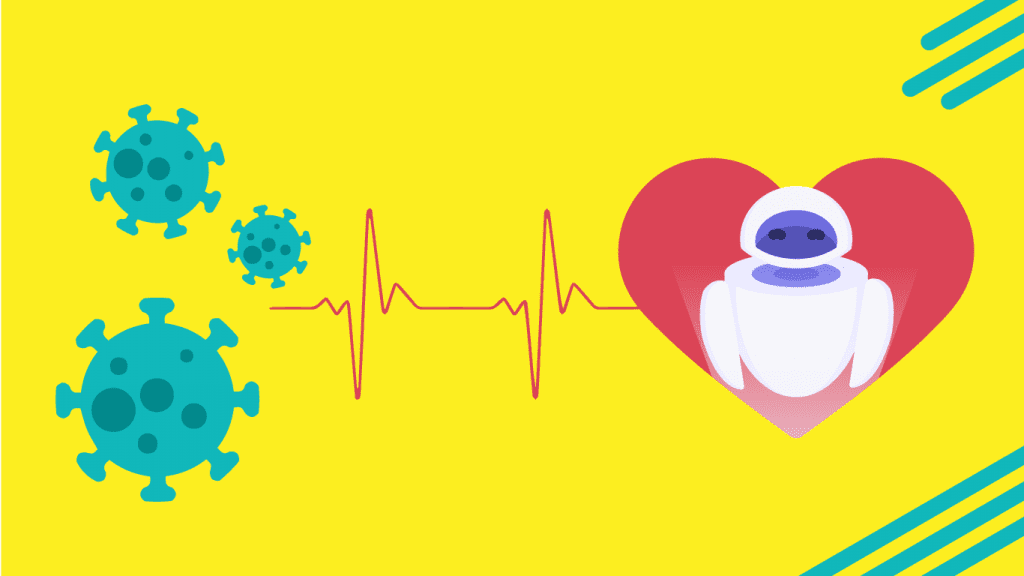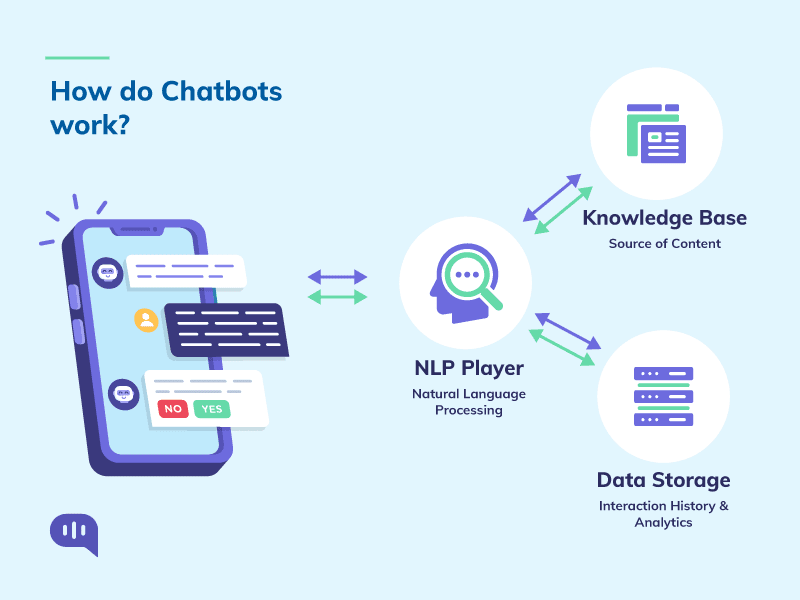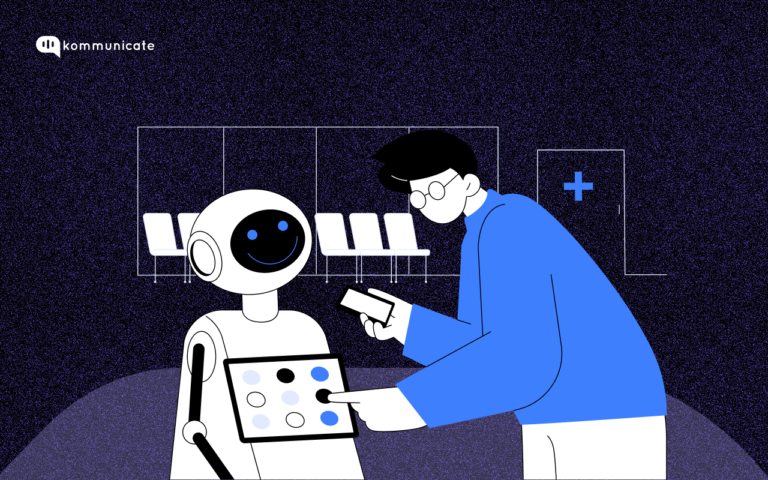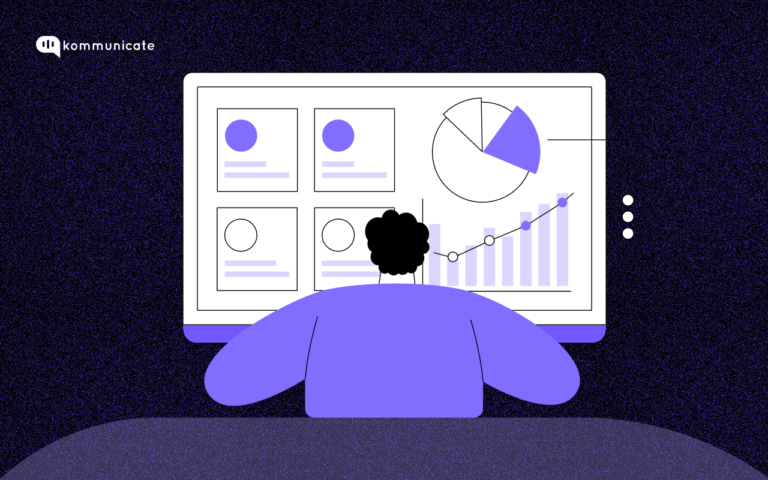Updated on June 8, 2022

Chatbots, a smart asynchronous means of communication, powered by AI has seen a high acceptance and penetration during the last few months. A number of industries started to believe they can be a great help for their business and can support when they are focussed on fixing a number of other issues.
A number of such chatbots are now deployed for the healthcare industry where medical professionals use them to support the cause of social distancing and help users with relevant answers.
Chatbots in healthcare are extremely critical for the advancement of efficient and accurate patient care. They are also expected to support the world’s need of creating affordable and sustainable health care for every individual on the planet.
Why are chatbots in healthcare growing so fast?
Continuous availability and ongoing support
Covid has been an eye-opener for the world why creating an ecosystem for public health is paramount. During hours of crisis, even paramedics and other allied servicemen become crucial to handle crises.
This also makes the world vulnerable to patients who are looking for urgent medical attention and guidance. Unfortunately, doctors have limited time, and having a set of requirements makes it impossible for them to cater to everyone.
Chatbots can play a wonderful role in supporting these patients and guide them with authentic and reliable information.
Scheduling Appointments and Other FAQs
A number of patients complain of very busy helpdesks. This often results in dissatisfaction among the visitors and their loved ones. Since a number of patients connect with health care institutions primarily to take appointments or find answers to generic issues, this can be extremely well handled by chatbots. Today’s chatbots can help in booking appointments and also respond to regular questions using the existing knowledge base.
They can also take up relevant information after booking the appointment which can help doctors understand the patient well and track all of their visits, follow-ups.
Building Trust Among Patients
Every medical institution needs to look progressive and the one who is looking to keep up with advancements in the world of technology. Chatbots have become a great way to build this trust as it caters with authentic information to users and at the right time.
For example, if someone is looking to meet a doctor then the chatbot by knowing its symptoms can easily recommend if she needs urgent attention or some basic medicines before she comes up for the checkup.
The reasons listed above have been the biggest drivers yesterday, today, and tomorrow for the growth of chatbots in the healthcare domain. However, one must also look at the reasons and risks involved which can stop this growth.
Challenges We Must Not Forget
Low Usage Among Senior Citizens
Some of the most vulnerable classes for healthcare don’t find it easy to use and confusing. One of the bigger challenges in front of healthcare providers is to get onboard this section of society. They have to look beyond just chat and can look to integrate the option of text as well. This can allow users to get answers and create a feeling similar to being treated by a doctor.
IT Vulnerability and Hacking Probabilities
One of the biggest challenges in front of chatbot creators is minimizing the vulnerability risks involved in creating sensitive and regulated information. A number of information shared to chatbots need to be highly secured and can’t be leaked. A number of precautions need to be taken to minimize cyber attacks and also any kind of information leaks
Well Tested Both From Performance and Information
Information that is shared with these chatbots is a matter of life and death sometimes. It is extremely vital that this information is well researched and also tested extensively to avoid any kind of mishaps. The information should be coming from a well researched and reliable source to avoid any last kind of issues
While we have understood the importance, need and risks involved while building a chatbot, it is extremely important for us to understand the process behind it as well. This will help us understand the technicalities far better and also explain the same to our visitors time and again.
Chatbots across all the industries work in a similar manner so understanding one can help you understand the rest too. Here the working mechanism has been considered for all three kinds of chatbots i.e. Rule-based, intellectually independent, and machine-based. You can read more about them from our last blog on “How chatbot works”.

Source: https://www.kommunicate.io/blog/what-are-chatbots/
From the above diagram you are able to understand how the data is processed and using the NLP layer the user’s inputs are validated and processed for the relevant answer.
Bonus: How to Build Coronavirus Chatbot
However, the following are the key highlights of the process
1. Some of the chatbots divide certain words into smaller tokens so that they can easily understand the process and also define its applications.
2. Chatbox is used for named entity fields like user name, gender, age, etc to understand better details about the user and then recommend the relevant answer
3. One of the key highlights of using NLP is understanding the phrases of our users and deciphering the exact meaning of the same. With dependency parsing, chatbots are able to identify different parts of speech such as nouns, verbs etc and understand the meaning of complex sentences as well.
Also, using sentiment analysis they can understand the real meaning of the words which are often called “homonyms”.
While we have understood the need and process of implementing chatbots it is crucial for us to understand the process of building it as well
How to build your own healthcare chatbot
A number of tools today can help you create your first chatbot in minutes. Let us understand the process of the same.
However, to use these tools you are no longer required to understand the world of coding but are primarily driven by drag and drop processes
Here I am using the NLP based codeless bot builder Kompose. You sign up here for 30 days free trial and follow further steps to build your healthcare chatbot.
- Login to your Kommunicate dashboard and click on Bot integration
- In the bot ‘Bot Integration‘ section >> Select Kompose >> Setup Bot
- You can create the following right away.
Welcome Message
A simple message on how your bot will behave once you are user initiates a conversation with your bot.
Answers
While you are discovering how to welcome your user it is also critical to see what are the probable answers for the bots to share. This is vital as understanding the user is crucial.
Small Talk
What are the various FAQs which the bots need to know?
You can feed all them here and users can get quick answers to that.
Fallback
This is important as leaving everything on the bot is not recommended. Creating a backup plan where a human can forward when the bot is not able to understand is crucial.
You can also check out the step by step process on How to make a chatbot
Once you are able to follow the above-listed steps you are almost halfway through the process of creating a basic chatbot for your business. It is vital that you are testing it extensively across multiple languages and devices to ensure that the experience is a good one for your user.
Some Useful Templates For Healthcare Chatbots
Now that you have a good understanding on how to create a chatbot your healthcare institute, here are some of the best practices for you to get started.
Booking a doctors appointment
Cato: Welcome to <Name of the entity>. We are a super specialty clinic with more than <number of doctors> under one roof. How can I help you today?
User: I need to book an appointment
Cato: Ok! Please let me know what kind of treatment you are looking for?
User: I need to consult a cardiologist
Cato: Ok. What is the best date and time for you to drop by?
User: 5th October anytime
Cato: Here are the available options
5th Oct, 10: 00 AM
7th Oct, 11:00 AM
9th Oct, 3.30 PM
Healthcare Services
Cato: Hi, Welcome to <Name of healthcare institute>, a super specialty clinic.
How can we help you today?
User: I am looking for a medical recommendation
Cato: Ok, I understand. To get started: Please do share your Name, Age, sex
User: I am Katen. I am 35 years old and a male.
Cato: Thanks a lot for sharing. Do let us know what are the challenges you are facing
User: I am having a mild fever for the last few days and also a pain in the throat
Cato: Ok, I see. Let me help you. I have a few more questions to ask: Is that ok?
User: Yes
So what are the use-cases of Chatbots in the healthcare industry?
Lead Generation:
Never miss out any of the visitors who are looking to know more about your services or trying to book a service
Specific Chatbots:
This pandemic has already taught us how every healthcare professional is critical for the world. With disease-specific chatbots, one can use the same for reaching out to multiple users at once with authentic information.
Customer Support:
Answer all the relevant questions or queries of the visitors in a flash. Have an extensive knowledge base for them to answer it quickly. You can train your bots too with time.
Feedbacks and Survey:
Take regular feedback about their experience and discover what all you can improve with time.
The use cases mentioned above are of generic nature and they can be expanded as per user behavior. Let us also look at some of the chatbots and its utility as per the current market requirements
- Florence: A chatbot that reminds users to take pills, track body weight, track mood, and also menstrual periods. It aims to behave like a nurse for an individual.
- Safedrugbot: A chatbot which aims to offer assistance to medical professionals with an extensive knowledge base about drug dosage and more.
- CancerChatbot: As the name suggests it is a chatbot used to guide patients and their loved ones on everything related to cancer. Whenever a user shares a query, the chatbot finds the best possible answer from a reliable database and shares.
- Sensely: A smart chatbot that is used to track symptoms from both text and speech. It’s the ability to understand the symptoms and recommend a diagnosis that has been a great attraction point for users and doctors.
- Woebot: A mental health chatbot which aims to understand the need and symptoms of users around mental health. The chatbot studies the mood, personality and recommends the best way forward.
Wrapping up
One thing we should remember after reading the evolution, growth and use cases about chatbot in healthcare domain. It is just the beginning of a revolution and it has just started.
The very purpose of introducing chatbots is to make life easy for users. In today’s world of extremely busy and hectic life traveling often becomes tedious. Also, finding an authentic and reliable resource is also becoming a challenge with so much noise around
These virtual assistants can be a great way to address these growing challenges as they can keep users engaged, help them when needed and also guide them to the best possible solution. The world can easily rely on them for creating an ecosystem of affordable and authentic healthcare.
In the future conversational AI will become the best way to help patients navigate through major challenges. The time ahead is surely exciting for chatbots in healthcare domain.






